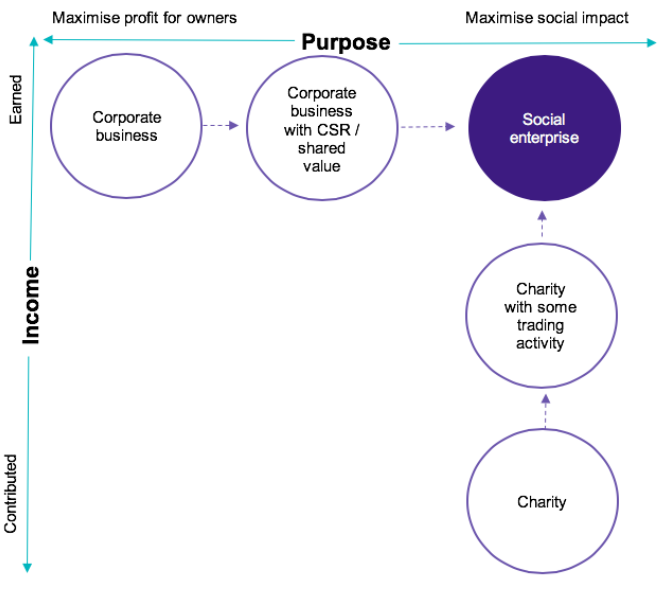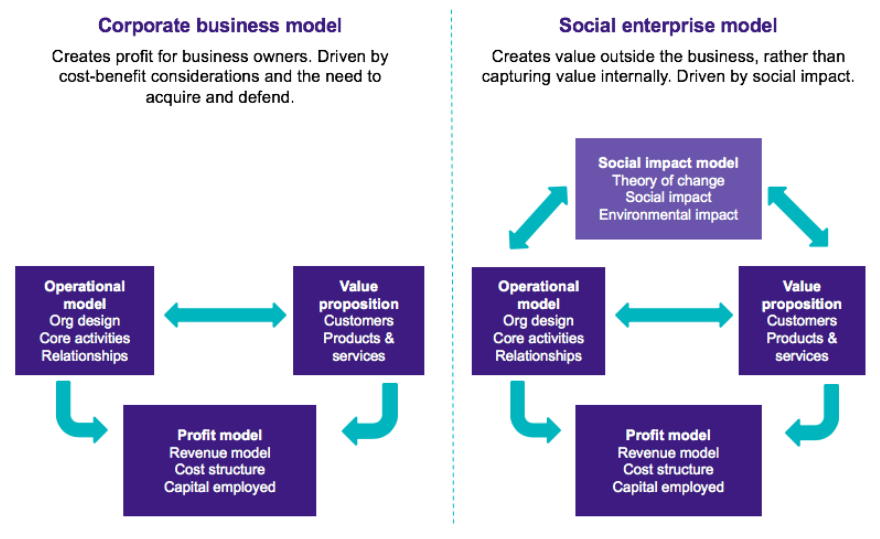Reimagining your social enterprise business model (part one): the why and what
The post-Covid world may offer new opportunities to push social enterprise as a force for good. But getting the business model right will be crucial. We’ve created a new social enterprise business model toolkit to help, based on a year of research in the UK. Part one explores the what and why of social enterprise business models, and the trade-offs to be managed.
A three part blog series covering our NEW social enterprise business model toolkit
After the shakeup of Covid-19, many of us will be in crisis and survival mode. But now is also the time to be thinking about the future and recovery phase. There will be new market opportunities as services and products are reimagined, new needs from our communities, and a more open space for business models with purpose as we question an economic system that valued GDP above all else.
We researched best practice on social enterprise business model design, but other than the social business model canvas, there wasn’t much out there. So we did our own research and produced the social enterprise business model toolkit. It’s based on a review of 92 international journal articles and interviews with leaders of social enterprise peak bodies in the UK that support over ten thousand social enterprises.
In this first of a three-part series, we set out the core components of any successful social enterprise, and pick apart the trade-offs you’ll need to manage when it comes to governance, operations, management, stakeholder management or strategic decision making.
A moment of opportunity: why now is the time for social enterprise
One thing Covid-19 has made abundantly clear (if it wasn’t already) is that our economy is not working. Small governments, diminished welfare systems and free markets left to dictate our way of life have left us vulnerable.
There has been lots of commentary about how after such a seismic black swan moment, we will not and cannot return to the way things were.
We knew this already. In 2019 the likes of the Economist and the Financial Times started running stories advocating for a rethink of capitalism. At the same time 180 of the world’s biggest companies overturned three decades of orthodoxy to pledge that their firms’ purpose was no longer to serve their owners alone, but customers, suppliers and communities too.
From the other side of the economy, there is growing interest from charities in generating income beyond traditional fundraising and grants. More are now looking to social enterprise models as a way to create trading revenue.
As we rebuild our economic system, we need social enterprises more than ever.
There are already thousands of social enterprises around the world. If we’re going to see more of them, and more of them growing, we need to go right to the heart of strategy and understand the business models that make them work.
Quick recap: what is a social enterprise?
Traditionally society was organised into three parts: the private sector, the government sector and the charity sector. But there is a grey space in between: the social enterprise sector.
Social enterprises are hybrids. They blend the commercial logic of the corporate sector with the social impact logic of the third sector and create a mash-up. They are the practical vehicle for building an organisation that can deliver both profit and purpose.

Social enterprises run like normal businesses that make a profit, but also have a social or environmental mission. The social mission is embedded right across the businesses into production processes, products, culture, and relationships with employees, suppliers and customers.
It’s their position in the grey space between the corporate and charity sector that gives social enterprises so much potential.
We need more of them. And we need the existing ones to scale and grow. For that to happen, we need to understand the business models that make them sustainable.
Social enterprise business model design: combining profit and purpose in practice
A social enterprise business model is a lot like a traditional corporate business model, but with one main difference. A corporate business model has three elements: the product/service offered to customers (value proposition), the way the company is organised to deliver this product and service to its customers (operational model), and the revenue model to generate a profit (value capture mechanism).
Social enterprise models have a fundamentally different starting point to their corporate business model cousins. Rather than a focus on the customer to generate profit and maximise value for the business owners, they have a clear intentionality around a social purpose for a beneficiary.
Rather than the purpose of strategy being to create and sustain competitive advantage (in order to make higher profits), the primary purpose of strategy for a social enterprise is to deliver social impact. That means social enterprises have a fourth component in their business model: the ‘social impact model’ that describes how social impact is generated and drives all business decisions.

For social enterprise, profitability is an enabler for social impact. For corporate businesses social impact (if any) is an enabler of profit. Rather than making profit the mission, social enterprises aim to make their mission profitable. This fundamentally impacts the way strategic choices are made, and business models are designed.
The trade-offs that need to be balanced
Running a social enterprise with the dual goals of profit and purpose is arguably far more complicated than traditional business. Social enterprises need to create unfamiliar combinations of activities not found in traditional business strategy.
There are greater complexities in social enterprise governance, operations, management, stakeholder management and strategic decision making.
| Tension | What it means in practice |
| Mission versus money | All decisions must be weighed according to two goals (profit and social impact) that are often conflicting. |
| Customers versus beneficiaries | Social enterprises have a commitment to a beneficiary group, and can’t simply switch to more profitable markets. |
| Social impact metrics versus profitability metrics | Social enterprises must measure total value including the social impact generated (not just the more straightforward financial metrics). |
| The broad social portfolio versus the deep social portfolio | Social enterprises must make tough choices about how to distribute services amongst different beneficiary groups that may all need support. |
| Stakeholders with social priorities versus stakeholders with commercial priorities | Marketing messages and the value proposition must be manipulated depending on the audience. |
| Competitors versus partners | Social enterprises with a shared vision should never stop their competitors from succeeding. |
| A profit driven culture versus a social mission culture | A balance between commercial and social priorities must be struck in decisions about who to hire, organisational legal structure and culture. |
| Short-term versus long-term thinking | One eye must be kept on long-term social impact (potentially decades), while the other must be kept on short-term financial sustainability. |
| Small and local versus big and global | Social enterprises must understand when growth and scale will threaten social impact, and avoid growth if necessary. |
| Personal goals versus organisational goals | Social enterprise executives must keep any personal motivations or personal connection to their cause in check. |
| Low cost versus ethical supply chains | Social enterprises must be as ethical as possible in their supply chains, but also remain affordable for beneficiaries. |
These challenges make it even more crucial to have a sound business model at the heart of your social enterprise. Part two and three of this series explain the business model types and the tools to help design them.
Summary
Our economy needs social enterprises more than ever, to create a new economy post Covid-19 that delivers value beyond GDP.
But it’s hard to find ‘ready-to-wear’ business models that enable the dual purpose of profit and social impact to be achieved.
The good news is that there are a number of social enterprise models that have been shown to work. In part two of this series we’ll explore them in detail and share examples – hopefully sparking ideas for how you might refresh or start-up your own social enterprise business model.

